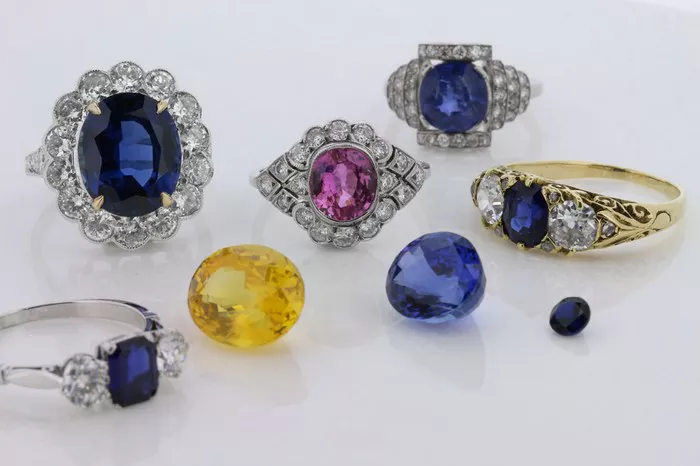Topaz and yellow sapphire are both gemstones that can be found in the jewelry market. They may sometimes be confused due to their similar yellowish hues. However, there are several distinct characteristics that can be used to tell them apart. Understanding these differences is crucial for jewelers, collectors, and consumers alike.
Color Characteristics
Shade and Hue
Yellow sapphire typically has a more vivid and saturated yellow color. The color can range from a pale yellow to a deep, intense golden – yellow. In high – quality yellow sapphires, the color is often evenly distributed throughout the stone. For example, in Sri Lankan yellow sapphires, the color is known for its rich and pure appearance.
Topaz, on the other hand, has a wider range of yellow shades. It can be a light, almost lemon – yellow, or a deeper, more golden – yellow. However, compared to yellow sapphire, the color of topaz may appear a bit more “washed – out” or less intense in some cases.
Color Zoning
Yellow sapphires may show some color zoning, especially in larger stones. This means that the color may be more concentrated in certain areas of the stone. However, in high – quality yellow sapphires, this zoning is often minimal.
Topaz can also show color zoning, but it may be more pronounced in some specimens. The zoning in topaz can sometimes give the stone a more mottled or patchy appearance in terms of color distribution.
Hardness and Durability
Mohs Hardness Scale
Yellow sapphire is a relatively hard gemstone, ranking 9 on the Mohs hardness scale. This high hardness makes it very durable and resistant to scratches. It can withstand the wear and tear of daily use in jewelry without easily getting scratched or damaged.
Topaz has a hardness of 8 on the Mohs scale. While it is still a fairly hard gemstone, it is not as hard as yellow sapphire. This means that topaz may be more prone to scratching over time, especially if it comes into contact with harder substances.
Cleavage
Yellow sapphire has no cleavage, which means it does not break along specific planes. This lack of cleavage contributes to its overall durability and makes it less likely to shatter.
Topaz has a perfect cleavage in one direction. This means that if topaz is hit or stressed in a certain way, it is more likely to break along this cleavage plane. This is an important factor to consider when handling and setting these gemstones.
Optical Properties
Refractive Index
Yellow sapphire has a relatively high refractive index. This results in a high level of brilliance and sparkle when the stone is cut and polished properly. The light refracts within the stone in a way that gives it a bright and lively appearance.
Topaz has a lower refractive index compared to yellow sapphire. As a result, it may not have the same level of brilliance. The sparkle of topaz is often a bit more subdued, although it can still be quite attractive depending on the cut and quality of the stone.
Birefringence
Yellow sapphire is anisotropic and has birefringence. This means that when light passes through the stone, it splits into two rays, which can sometimes be observed as a doubling of edges or facets when looking through the stone under certain conditions.
Topaz also has birefringence, but the effect is different from that of yellow sapphire. The birefringence in topaz is generally less pronounced and may not be as easily noticed without close inspection.
Inclusions
Typical Inclusions in Yellow Sapphire
Yellow sapphires may contain inclusions such as rutile needles, zircon crystals, or other mineral inclusions. These inclusions can sometimes be used to help identify the origin of the sapphire. For example, certain types of inclusions may be more common in sapphires from specific geographical regions.
In high – quality yellow sapphires, the inclusions are often small and do not significantly detract from the overall appearance of the stone. However, in lower – quality specimens, larger inclusions may be present.
Inclusions in Topaz
Topaz can contain inclusions such as fluid inclusions or mineral inclusions. These inclusions may be different in nature from those found in yellow sapphires. In some cases, the inclusions in topaz can give the stone a cloudy or hazy appearance if they are numerous or large enough.
Conclusion
In conclusion, distinguishing between topaz and yellow sapphire requires a careful examination of several factors. The color, hardness, optical properties, and inclusions all play important roles in differentiating these two gemstones. By understanding these differences, one can accurately identify whether a gemstone is a yellow sapphire or a topaz. This knowledge is not only valuable for those in the jewelry industry but also for consumers who want to ensure that they are getting the gemstone they expect when purchasing jewelry. Whether it is for investment, collection, or simply for personal adornment, being able to distinguish between topaz and yellow sapphire is an essential skill in the world of gemstones.
Related topic:
- Can Emerald and Yellow Sapphire Be Worn Together?
- Can Yellow Sapphire and Cat’s Eye Be Worn Together?
- Can Yellow Sapphire and Blue Sapphire Be Worn Together?


